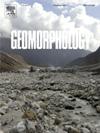风沙在颗粒纹面上的输运及其对地貌演化的意义
IF 3.1
2区 地球科学
Q2 GEOGRAPHY, PHYSICAL
引用次数: 0
摘要
风沙运输造成了一系列沙害和严重的空气污染,但也在干旱和半干旱地区塑造了复杂的景观。以前对风成输运的研究主要集中在不同表面(如沙质和砾石床)上的颗粒输运率或通量密度,或者将这些因素与控制细粒度床形(包括沙丘和沙波纹)的动态过程联系起来。对颗粒波纹的研究较少。沉积物呈双峰状分布,顶部被粗粒包裹。地表以上的风成输运特征对了解其形态动力学过程至关重要,但在野外研究很少。为了提供这些缺失的数据,我们利用吹沙陷阱在中国库姆塔格沙漠北部的颗粒波纹表面进行了六次观测,以阐明风沙运输对地貌的影响。通量密度随高度的增加呈指数递减,但不同粒度组的通量密度垂直分布存在较大差异。输运颗粒主要为细粒至中粒砂,粗粒至极细粒砂在高风速下也发生了跃移。风速对风沙输运过程有显著影响,不同粒径的颗粒对不同的阈值风速有不同的响应,其输运方式也不同。我们将选择性、双峰和单峰输运过程与颗粒波纹的形态演化及其沉积结构的形成联系起来。我们建议应充分考虑粗颗粒的跃变,以完善颗粒波纹演化的理论框架。本文章由计算机程序翻译,如有差异,请以英文原文为准。
Aeolian sediment transport over a granule ripple surface and its implications for geomorphological evolution
Aeolian sediment transport causes a range of sand hazards and serious air pollution, but also sculpts intricate landscapes in arid and semi-arid areas. Previous studies of aeolian transport have mainly focused on the particle transport rate or flux density above various surfaces, such as sandy and gravelly beds, or have linked these factors to the dynamic processes that govern fine-grained bedforms, including dunes and sand ripples. Granule ripples have been studied less. Their sediments exhibit a bimodal size distribution, and they are armored by coarse grains at the crest. The aeolian transport characteristics above their surface are crucial for understanding their morphodynamic processes, but have been rarely studied in the field. To provide this missing data, we conducted six observations using a blowing-sediment trap on the surface of granule ripples in the northern part of China's Kumtagh Desert to elucidate the geomorphological effects of aeolian transport. The flux density decreased exponentially with increasing height, but with substantial differences in the vertical profiles of flux density for different grain-size groups. The transported particles were predominantly fine to medium sands, although coarse sands to very fine gravels also underwent saltation at high wind speeds. Wind strength significantly influenced the aeolian transport process, with particles of different sizes responding to different threshold velocities and engaging in different transport modes. We related selective, bimodal, and unimodal transport processes to the morphological evolution of granule ripples and the formation of their sedimentary structure. We suggest that the saltation of coarse particles should be fully considered to refine the theoretical framework for granule ripple evolution.
求助全文
通过发布文献求助,成功后即可免费获取论文全文。
去求助
来源期刊

Geomorphology
地学-地球科学综合
CiteScore
8.00
自引率
10.30%
发文量
309
审稿时长
3.4 months
期刊介绍:
Our journal''s scope includes geomorphic themes of: tectonics and regional structure; glacial processes and landforms; fluvial sequences, Quaternary environmental change and dating; fluvial processes and landforms; mass movement, slopes and periglacial processes; hillslopes and soil erosion; weathering, karst and soils; aeolian processes and landforms, coastal dunes and arid environments; coastal and marine processes, estuaries and lakes; modelling, theoretical and quantitative geomorphology; DEM, GIS and remote sensing methods and applications; hazards, applied and planetary geomorphology; and volcanics.
 求助内容:
求助内容: 应助结果提醒方式:
应助结果提醒方式:


